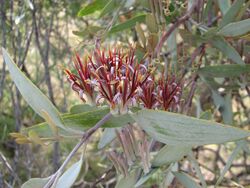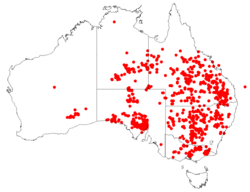Biology:Amyema quandang
| Amyema quandang | |
|---|---|

| |
| Scientific classification | |
| Kingdom: | Plantae |
| Clade: | Tracheophytes |
| Clade: | Angiosperms |
| Clade: | Eudicots |
| Order: | Santalales |
| Family: | Loranthaceae |
| Genus: | Amyema |
| Species: | A. quandang
|
| Binomial name | |
| Amyema quandang | |
| Varieties | |
|
A. quandang var. quandang[2] | |

| |
| Collections data for A. quandang from the Australasian Virtual Herbarium | |
Amyema quandang is a species of hemi-parasitic shrub which is widespread throughout the mainland of Australia , especially arid inland regions, sometimes referred to as the grey mistletoe.[4]
Description
An aerial shrub, without conventional roots, which attaches to the stems of species of Acacia. The leaves are leathery and greyish, and lanceolate to broadly ovate.[1] Flowers are red, green and grey and appear sometime between April and October. The fruit is a fleshy drupe, between 6 and 10 millimetres long, which contains an oily seed.[5]
Ecology
The plant has a hemi-parasitic relationship with Acacia, it is recorded on: A. aneura, A. cambagei, A. papyrocarpa, A. omalophylla and A. dealbata.[1]
Two species of birds are noted for their interdependence, or mutualism, where they occur with A. quandang in the arid interior of Australia. Nectar from the species provides an important part of the diet of spiny-cheeked honeyeaters Acanthagenys rufogularis, who assist in its pollination. The fruit is consumed by mistletoebirds, Dicaeum hirundinaceum, who disperse the seed; the year round availability of the fruit is ignored by other frugivores.[6]
The hybridisation of this species with Amyema pendula, rare amongst Loranthaceae, has produced first generation hybrids.[7]
Taxonomy
Amyema quandang is member of Santalales, the mistletoe order, placed within the family Loranthaceae. The first publication of the species was made in a note by John Lindley in 1838,[8] describing the plant noted by Thomas Mitchell as growing on Santalum acuminatum, another hemiparasite known as quandong.
May 9. We moved to the pond above-mentioned, named Yambarenga ... and in some places I observed the Quandang bushes,* having their branches covered with a parasitical plant whose bright crimson flowers were very ornamental.**[8]
(*Footnote. Fusanus acuminatus.)
— Lindley, Mitchell, 1838[9]
The description in the genus Loranthus remained until Philippe Édouard Léon Van Tieghem transferred it to the genus Amyema in 1894.[10][11] The genus name is derived from Greek for 'without' and 'to instruct'.[12]
Two varieties of the species are described, Amyema quandang var. quandang and Amyema quandang var. bancroftii (F.M.Bailey) Barlow,[13] the latter being found in Queensland and New South Wales.[3]
Host plants
The following host plants are known:[14]
List of host plants
| |
|---|---|
|
Image Gallery
References
- ↑ 1.0 1.1 1.2 "Amyema quandang (Lindl.) Tiegh.". PlantNET - New South Wales Flora Online. Royal Botanic Gardens & Domain Trust. http://plantnet.rbgsyd.nsw.gov.au/cgi-bin/NSWfl.pl?page=nswfl&lvl=sp&name=Amyema~quandang.
- ↑ "Amyema quandang var. quandang (Lindl.) Tiegh.". PlantNET - New South Wales Flora Online. Royal Botanic Gardens & Domain Trust. http://plantnet.rbgsyd.nsw.gov.au/cgi-bin/NSWfl.pl?page=nswfl&lvl=in&name=Amyema~quandang~var.+quandang.
- ↑ 3.0 3.1 "Amyema quandang var. bancroftii (Lindl.) Tiegh.". PlantNET - New South Wales Flora Online. Royal Botanic Gardens & Domain Trust. http://plantnet.rbgsyd.nsw.gov.au/cgi-bin/NSWfl.pl?page=nswfl&lvl=in&name=Amyema~quandang~var.+bancroftii.
- ↑ "19 Mistletoe Amyema (various species)". Aboriginal Plant Use in South-Eastern Australia. Australian National Herbarium. Archived from the original on 25 June 2009. https://web.archive.org/web/20090625184426/http://www.anbg.gov.au/aborig.s.e.aust/amyema-species.html. Retrieved 2009-07-10.
- ↑ "Amyema quandang (Lindl.) Tiegh.". FloraBase. Western Australian Government Department of Parks and Wildlife. https://florabase.dpaw.wa.gov.au/browse/profile/2384.
- ↑ Reid, Nick (July 28, 2006). "Mutualistic interdependence between mistletoes (Amyema quandang), and spiny-cheeked honeyeaters and mistletoebirds in an arid woodland". Austral Ecology (Ecological Society of Australia) 15 (2): 175–190. doi:10.1111/j.1442-9993.1990.tb01526.x.
- ↑ , Wikidata Q57405840
- ↑ 8.0 8.1 [from Mitchell](**Footnote. Loranthus quandang, Lindley manuscripts; incanus, foliis oppositis lineari-oblongis obsolete triplinerviis obtusis, pedunculis axillaribus folio multo bevioribus apice divaricato-bifidis 6-floris, floribus pentameris aequalibus, petalis linearibus, antheris linearibus basi insertis. Next L. gaudichaudi.)
- ↑ Lindley, J, Mitchell, T.L., ed., 2, pp. 69, https://www.biodiversitylibrary.org/page/56306156, Wikidata Q6146213
- ↑ , pp. 507, Wikidata Q54801450
- ↑ "Amyema quandang (Lindl.) Tiegh.". Australian Plant Name Index (APNI), IBIS database. Centre for Plant Biodiversity Research, Australian Government. http://www.anbg.gov.au/cgi-bin/apni?taxon_id=33418.
- ↑ "Amyema". FloraBase. Western Australian Government Department of Parks and Wildlife. https://florabase.dpaw.wa.gov.au/browse/profile/22387.
- ↑ Amyema quandang var. bancroftii (F.M.Bailey) Barlow. , Wikidata Q54801356
- ↑ , Wikidata Q106567982
Wikidata ☰ Q4749513 entry
 |

